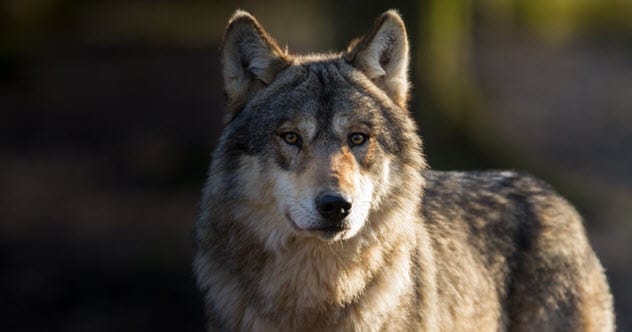Wolves, often seen as simple creatures of the wild, lead surprisingly complex lives. Whether they’re prowling through forests or relaxing in zoos, there’s more to these animals than meets the eye. News reports about individual wolves reveal stories of adventure, humor, and courage, showcasing their unique personalities and experiences.
Here are ten remarkable wolf stories that made the headlines.
The Mystery Michigan Wolf: Shot as a “Coyote”
In early 2024, during a legal coyote hunt in southwest Michigan, a hunter shot what he thought was a large coyote. Upon closer inspection, he realized it was a gray wolf. This was significant because gray wolves hadn’t been seen in that area for at least a century.
The appearance of the wolf so far south is a mystery. Michigan’s established gray wolf population resides in the Upper Peninsula, far to the north. For a wolf from that population to end up in southern Michigan, it would need to cross the Mackinac Bridge, one of the world’s longest suspension bridges.
Experts believe this was an isolated incident and don’t anticipate wolves returning to the southern Lower Peninsula, where they were hunted to extinction long ago. [1]
Unnamed Suspect Stole Surveillance Equipment
The Help Alberta Wildies Society (HAWS) studies wild horses in Alberta, Canada. As part of their research, HAWS uses trail cameras at various locations. In 2023, one of these cameras disappeared.
The culprit? A wolf. Captured on another HAWS camera, nighttime footage showed the wolf running off with the device in its mouth. Another wolf was present but showed no interest in the equipment. The pair was identified as belonging to a pack of seven that frequently passed through HAWS research areas.
It’s unclear why the wolf took the camera, but curiosity is the likely reason. The camera was later found badly chewed, suggesting the wolf played with it or tried to figure it out. [2]
Soleil Ellen: Survived an Amputated Leg
In April 2023, Soleil Ellen, a three-year-old Mexican gray wolf, arrived at the Living Desert Zoo and Garden in California. For about six months, she integrated well with the existing pack of two males. However, in November, a tragic accident occurred in her enclosure.
Mexican gray wolves are known for their active nature, often engaging in rough play and acrobatic jumps. During one of these leaps, Soleil Ellen landed awkwardly and fractured her right front leg.
Euthanasia was not an option due to the rarity of Mexican gray wolves. A plaster cast was also deemed unsuitable because the lengthy recovery would cause too much stress. The decision was made to amputate the leg for faster healing and less mental suffering.
After the surgery, Soleil Ellen quickly adapted to life as a tripod. She returned to her enclosure and resumed splashing in the pond, running, climbing, and playing with the other wolves. [3]
2225 and 2323: Priceless Parents and Foster Family
Breeding pair 2225 (the mother) and 2323 (the father) are conservation heroes. As critically endangered red wolves, their species was once extinct in the wild. These two wolves, living in a wildlife refuge in North Carolina, made history by producing the first wild-born litter in five years.
Their first litter of five pups arrived in 2022. A year later, another litter of five joined the pack. Recognizing their exceptional parenting, conservationists added a zoo-born puppy to the new litter, which the adults promptly adopted and cared for.
This 13-member pack offers a significant boost to the red wolf species, which has been on the brink of extinction for years. Each generation born and raised in the wild increases their genetic diversity and numbers. Currently, only about 30 wild red wolves roam free, with another 270 in captivity. [4]
Wolf 907F: Yellowstone Record Breaker
In 2024, a wolf in Yellowstone National Park gained attention for having puppies. What made this birth special was the mother’s age and consistent litter production. Wolf 907F reached sexual maturity at one year old and had a litter every year since. In 2024, at the age of 11, she had her tenth litter, a record for Yellowstone.
This wolf is also remarkable for other reasons. She lost an eye before the age of four, yet she became the alpha female of the Junction Butte pack, a large group of gray wolves in the park’s Northern Range.
Her survival skills and experience likely contribute to the pack’s success. She knows how to handle conflicts with rival packs, avoid humans, and safely cross roads. Now, Wolf 907F spends more time with the pups while the younger adults hunt. [5]
Tempest: Survived Vandalism That Killed Her Pack Mate
In 2022, keepers at the Greater Vancouver Zoo discovered that someone had deliberately cut the fence around the gray wolf enclosure, allowing all nine wolves to escape.
Seven wolves were captured and returned safely. However, Chia, the second oldest female, was found dead near a road, likely hit by a vehicle.
This news increased concerns for the safety of the last missing wolf, Tempest, who was born at the zoo a year prior. With no experience of roads and humans, she was at great risk.
After a three-day search, rescue teams found Tempest uninjured and close to the zoo. [6]
Maya: The World’s First Wolf Clone
In 2022, a beagle in a Beijing laboratory gave birth to Maya, an Arctic wolf. This event marked a significant milestone in cloning and conservation.
Maya was the first wolf clone ever born, highlighting the growing role of private companies in cloning pets for grieving owners.
Cloning is expensive, and traditionally done by underfunded universities, limiting its frequency. Private labs, like the one that created Maya, have more resources to clone endangered species.
Sinogene Biotechnology Company used DNA from another female wolf, also named Maya, who was born in Canada and died in China in 2021. They created 137 embryos, implanting 85 into dog surrogates. Only one embryo was carried to term, resulting in the new Maya. [7]
The Wanderer: Traveled 3,000 Miles in 6 Months
In 2010, biologists placed a GPS collar on a wolf, tagged as Wolf 258. He was two or three years old and in good health. He seemed settled after pair-bonding with a female in Alaska’s Yukon-Charley Rivers National Preserve.
However, after his mate died, Wolf 258 embarked on an epic journey. People called him “The Wanderer,” which inspired a book.
GPS data showed he stayed in his mate’s territory for three months before moving north. He traveled 25 miles (40 kilometers) or more daily, crossing the Arctic National Wildlife Refuge and passing through the territories of hundreds of other wolves without being killed.
Ultimately, starvation ended his journey. His collar emitted a “death” signal on October 18. Researchers found his emaciated body a mile from the Dalton Highway, with only brown liquid and tapeworms in his stomach. After traveling nearly 3,000 miles across Alaska, he succumbed to starvation. [8]
The Old Gray Guy: Revived an Entire Ecosystem
By the 1990s, the gray wolf population on Isle Royale was struggling due to inbreeding, which led to poor health and spinal deformities.
This hampered their ability to hunt moose, leading to a population boom in the herbivore. The overgrazing decimated the forest ecosystem and strained other species dependent on the trees.
In 1997, an ice bridge briefly connected the island to Canada. A single wolf, later called M93 or “The Old Gray Guy,” crossed over, bringing new genes to the island.
His large size allowed him to quickly take over a pack and provide them with plenty of moose meat. He fathered 34 pups, greatly improving the genetic health and hunting success of the island’s wolves. This kept the moose population in check, helping the trees recover.
Unfortunately, isolation again impacted the wolves. By 2019, only two wolves remained. Recent efforts have started to bring more wolves to the island, bypassing the need for ice bridges affected by climate change. [9]
Kunxun: A Crimefighting Clone
While Maya was the first clone of a full wolf in 2022, wolf-dog hybrids had already achieved this milestone four years earlier. Huahuangma, a Kunming wolf-dog used by Chinese police for her exceptional scent-detecting abilities, was known as a “Sherlock Holmes” of canines.
The Yunnan Province police department wanted more dogs like Huahuangma. However, breeding her wouldn’t guarantee the puppies would inherit her excellent sniffing abilities and other valuable traits. Cloning was the solution.
In 2018, Huahuangma’s clone, Kunxun, was born at the Sinogene Biotechnology Company. Kunxun was 99.9% identical to Huahuangma and outperformed traditionally bred Kunming wolf-dogs by three months old. If successful, Huahuangma clones could significantly reduce the training time and costs for police dogs. [10]
Conclusion
From Michigan’s mysterious lone wolf to the crime-fighting clone in China, these ten stories highlight the fascinating lives and capabilities of wolves. Whether it’s surviving against the odds, contributing to conservation efforts, or displaying remarkable adaptability, these wolves have captured our attention and admiration. Their tales remind us of the depth and complexity of the natural world.
Which of these wolf stories did you find most intriguing? Leave your thoughts in the comments below!










